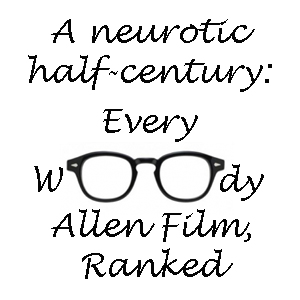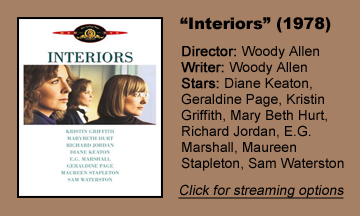“Interiors” (1978) is a rare Woody Allen film where I wouldn’t know it’s an Allen film if I went in cold and skipped the opening credits. This is because there isn’t a funny line of dialog in the whole movie. The dramatic – even tragic – tone (as opposed to the writer-director’s usual comedic sensibilities) is purposeful.
Indeed, I wouldn’t be surprised if Allen challenged himself to include precisely zero moments of humor. In this movie, suicide is not present merely as a punchline or a funny failed attempt; it’s something that happens, with the appropriate weight attached.
Dropping the comedy
Sort of a non-comedic trial run for the 1986 masterpiece “Hannah and Her Sisters,” “Interiors” is a study of three grown sisters – Diane Keaton’s Renata, Mary Beth Hurt’s Joey and Kristin Griffith’s Flyn – dealing with various levels of success (or lack thereof) in artistic fields, while also trying to soothe their depressed interior-decorator mother, Eve (Geraldine Page).
Although “Interiors” values family bonds, Eve is a cautionary tale about being too attached to one individual, as the separation from her husband Arthur (E.G. Marshall) destroys her.
The closest to a Woody Allen Character (in the sense that Allen could be playing the role) is Renata, who speaks to her off-screen therapist about her fear of dying. She later expresses to her husband, Frederick (Richard Jordan), that she sometimes feels disconnected from her body.
It’s hard to imagine Allen – at least judging by his early roles — playing a male version of Renata and not having him come off somewhat funny, but Keaton has the range. She looks 20 years older than she did one year prior in “Annie Hall,” with credit also due to the downbeat tone and the makeup team.
Renata and Frederick are writers, while Flyn is an actress aging out of youthful roles and Joey is a photographer without talent. I especially enjoyed seeing Sam Waterston as Joey’s husband Mike, a political scholar and activist. Knowing him from “Law & Order,” it’s surprising to see him as a young man.
No outright villains
“Interiors” has no outright villains, although it does show how people can hurt each other without evil intent. I never feel Arthur is wrong for separating from Eve; he makes a fair argument that he deserves a chance to be happy now that his daughters are grown. At the same time, my heart breaks for Eve.
The title is smart, as it provides a key to understanding what Allen is aiming for. He can’t put the camera and microphone in the characters’ gray matter, but he gets as close as possible. During the wedding vows of Arthur and Pearl (Maureen Stapleton), the camera holds on the sad, tired face of Joey.
Officially, she is happy for her father, but she knows this marriage is crushing her fragile mother. When only the camera sees her, Joey’s interior becomes her exterior.

Like a sparse stage play
Joel Schumacher, who became a style-oriented director known most infamously for “Batman & Robin,” is the costume designer for “Interiors.” But like a lot of Allen’s 1970s films, this one isn’t particularly lavish. (When Pearl joins the family, she wears floral prints that match a bubbly personality that outstrips even that of Flyn, the ingénue.)
Even with an Atlantic beachfront home being a primary setting, this is not a pretty film. (It seems to be set in the tourism offseason.) It’s one of those movies that’s in color, but you come away thinking it was in black and white.
“Interiors” is like an old-fashioned stage play. Eve likely is depressed in the clinical sense of the word, but – while her daughters, ex-husband and doctor care about her – there’s no talk of medication.
There’s not much suggestion of therapy, either, even though that’s a staple of Allen’s work. I think the frustration we feel about Eve being beyond help is the point, but I wonder if Allen cheats a little by not offering more potential solutions.
I admire “Interiors” more than I like it. Allen’s films tend to be intensely rewatchable, but this one not so much. Still, it’s impressive that it’s so engaging on one viewing – thanks to Allen’s knack for creating real people who speak naturally – considering that he offers no escapes into laughter.


